Prediction of Favorable Sand Bodies in Fan Delta Deposits of the Second Member in Baikouquan Formation, X Area of Mahu Sag, Junggar Basin
Abstract
1. Introduction
2. Geological Setting
3. Data and Methods
3.1. Dataset
3.2. Methodology
4. Results
4.1. Sedimentary Facies Signatures
4.1.1. Petrographic Analysis
4.1.2. Sedimentary Microfacies Characteristics
4.1.3. Logging Facies Characteristics
- (1)
- Thick-layer box type
- (2)
- Bell shape
- (3)
- Finger shape
- (4)
- Funnel-shape
- (5)
- Linear type
4.1.4. Seismic Facies Characteristics
4.2. Planar Distribution of Sedimentary Facies
4.3. Sand Body Prediction
4.3.1. Seismic Waveform Indicative Inversion
4.3.2. Sand Ratio Forecast
4.3.3. Favorable Sand Body Prediction
4.4. Sedimentary Mode
5. Conclusions
- (1)
- The second member of the Baikouquan Formation (T1b2) is predominantly composed of fan delta front deposits. These are subdivided into three main sedimentary microfacies: subaqueous distributary channels, subaqueous interdistributary bays, and distal bars. The subaqueous distributary channel facies, primarily consisting of grayish-green sandy conglomerates, represents the most favorable reservoir unit.
- (2)
- The distribution of sand bodies is controlled by northwestern sediment sources and a gentle paleo-slope. Two major NW-SE trending distributary channel systems are identified, which converge in the BAI65 well area. These channels exhibit a radial pattern and form vertically stacked and laterally contiguous sand bodies, with significant accumulation around the MAXI1, AIHU10, AICAN1 well areas and west of the MA18 well.
- (3)
- Seismic Waveform Indicative Inversion (SWII), effectively constrained by stratal slicing and sedimentary facies boundaries, was successfully applied to predict high-quality sand bodies. The inversion results reveal that favorable subaqueous distributary channel sands are predominantly distributed in the central and western parts of the study area, covering a cumulative area of approximately 159.2 km2. And by comparing the actual drilling data of 10 Wells with the predicted data, the prediction coincidence rate in the target layer section with the highest drilling encounter rate was 100% (Table 4).
- (4)
- The fan delta plain comprises tight sandstones, while high-quality reservoirs are primarily developed within the fan delta front subfacies. The methodology employed in this study, which integrates geological boundaries with seismic inversion, provides a practical and effective means for reservoir prediction during the rolling exploration and development phase, as demonstrated by its successful application in guiding well placement.
Author Contributions
Funding
Data Availability Statement
Conflicts of Interest
References
- Zeng, H.; GEOB. From Seismic Stratigraphy to Seismic Sedimentology: A Sensible Transition. Am. Assoc. Pet. Geol. Bull. 2001, 85, 413–420. [Google Scholar]
- Zeng, H.; Xu, L.; Wang, G. Prediction of ultrathin lacustrine sandstones by joint investigation of tectonic geomorphology and sedimentary geomorphology using seismic data. Mar. Pet. Geol. 2016, 78, 759–765. [Google Scholar] [CrossRef]
- Posamentier, H.W. Seismic Geomorphology: Imaging Elements of Depositional Systems from Shelf to Deep Basin Using 3D Seismic Data: Implications for Exploration and Development; Geological Society: London, UK, 2004; Volume 29, pp. 11–24. [Google Scholar]
- Posamentier, H.W.; Kolla, V. Seismic Geomorphology and Stratigraphy of Depositional Elements in Deep-Water Settings. J. Sediment. Res. 2003, 73, 367–388. [Google Scholar] [CrossRef]
- Kolla, V.; Bourges, P.; Urruty, J. Evolution of Deep-Water Tertiary Sinuous Channels Offshore Angola (West Africa) and Implications for Reservoir Architecture. GeoScienceWorld 2001, 85, 1373–1405. [Google Scholar]
- Zeng, H.; Zhu, X.; Zhu, R. Guidelines for seismic sedimentologic study in non-marine postrift basins. Pet. Explor. Dev. Online 2012, 39, 295–304. [Google Scholar] [CrossRef]
- Wu, W.; Li, Q.; Yu, J. The Central Canyon depositional patterns and filling process in east of Lingshui Depression, Qiongdongnan Basin, northern South China Sea. Geol. J. 2018, 53, 3064–3081. [Google Scholar] [CrossRef]
- Xu, Z.; Hu, S.; Wang, L. Seismic sedimentologic study of facies and reservoir in middle Triassic Karamay Formation of the Mahu Sag, Junggar Basin, China. Mar. Pet. Geol. 2019, 107, 222–236. [Google Scholar] [CrossRef]
- Jia, H.; Ji, H.; Wang, L. Controls of a Triassic fan—Delta system, Junggar Basin, NW China. Geol. J. 2018, 53, 3093–3109. [Google Scholar] [CrossRef]
- Tan, C.; Yu, X.; Liu, B. Conglomerate categories in coarse-grained deltas and their controls on hydrocarbon reservoir distribution, a case study of the Triassic Baikouquan Formation, Mahu Depression, NW China. Pet. Geosci. 2017, 23, 403–414. [Google Scholar] [CrossRef]
- Gao, C.; Ji, Y.; Ren, Y. Geomorphology and sedimentary sequence evolution during the buried stage of paleo-uplift in the Lower Cretaceous Qingshuihe Formation, Junggar Basin, northwestern China: Implications for reservoir lithofacies and hydrocarbon distribution. Mar. Pet. Geol. 2017, 86, 1224–1251. [Google Scholar] [CrossRef]
- Xiao, Z.; Chen, S.; Zhao, R. Total organic carbon logging evaluation of Fengcheng source rock in the western Mahu Sag, Junggar Basin, China. Energy Sources Part A Recovery Util. Environ. Eff. 2025, 47, 7856–7866. [Google Scholar] [CrossRef]
- Guo, X.; Luo, X.; Mao, R. The genesis of solid bitumen and its effect on reservoir physical properties. Energy Sources Part A Recovery Util. Environ. Eff. 2025, 47, 430–443. [Google Scholar] [CrossRef]
- Wu, W.; Tang, Y.; Zhao, J. Model of Tight Conglomerate Oil Accumulation in the Mahu Sag, Junggar Basin, Northwest China. J. Earth Sci. 2025, 36, 1149–1167. [Google Scholar] [CrossRef]
- Liu, D.W.; Ji, Y.L.; Gao, C.L.; Zhong, J. Lithofacies characteristics and sedimentary model of a gravelly braided river-dominated fan: A case study of modern Poplar River alluvial fan (northwest Junggar Basin, China). Aust. J. Earth Sci. 2021, 68, 1179–1200. [Google Scholar] [CrossRef]
- Su, A.; Chen, H.; Lei, M. Paleo-pressure evolution and its origin in the Pinghu slope belt of the Xihu Depression, East China Sea Basin. Mar. Pet. Geol. 2019, 107, 198–213. [Google Scholar] [CrossRef]
- Xie, A.; Wu, H.; Tang, Y. Classification and Analysis of Dominant Lithofacies of the Fengcheng Formation Shale Oil Reservoirs in the Mahu Sag, Junggar Basin, NW China. Processes 2025, 13, 1065. [Google Scholar] [CrossRef]
- Lv H, J.; Hu, T.; Zhang, W. Microscopic oil occurrence in the Permian alkaline lacustrine shales, Fengcheng formation, Mahu Sag, Junggar basin. Pet. Sci. 2025, 22, 1407–1427. [Google Scholar] [CrossRef]
- Wang, S.; Wang, G.; Zeng, L. New method for logging identification of natural fractures in shale reservoirs: The Fengcheng formation of the Mahu Sag, China. Mar. Pet. Geol. 2025, 176, 107346. [Google Scholar] [CrossRef]
- Yang, L.; Junming, W.; Wenquan, Z. Analysis of various parameters in soaking: A case study of Permian Fengcheng Formation in Mahu Sag, Junggar Basin, China. Arab. J. Geosci. 2025, 18, 60. [Google Scholar] [CrossRef]
- Tang, Y.; Jia, C.; Chen, F. Relationship between pore throat structure and crude oil mobility of full particle sequence reservoirs in Permian Fengcheng Formation, Mahu Sag, Junggar Basin, NW China. Pet. Explor. Dev. Online 2025, 52, 112–124. [Google Scholar] [CrossRef]
- Tang, Y.; Wei, X.; Yan, D. The Effect of Pre–Triassic Unconformity on a Hydrocarbon Reservoir: A Case Study from the Eastern Mahu Area, Northwestern Junggar Basin, China. Minerals 2024, 14, 1277. [Google Scholar] [CrossRef]
- Zhang, C.; Hu, Q.; Wang, Q. Effects of solvent extraction on pore structure properties and oil distribution in shales of alkaline lacustrine basins. Mar. Pet. Geol. 2024, 171, 107207. [Google Scholar] [CrossRef]
- Jia, L.; Yang, Z.; Gao, Z. The Occurrence Characteristics and Enrichment Patterns of Shale Oil in Different Lithofacies: A Case Study of the Fengcheng Formation in the Mahu Sag. ACS Omega 2024, 9, 46505–46518. [Google Scholar] [CrossRef]
- Li, M.; Zhang, Q.; Zhu, Z. Pore structure characteristics of low oil saturation reservoirs in Badaowan Formation of Mahu Sag, Junggar Basin, China. Geosyst. Eng. 2024, 27, 319–335. [Google Scholar] [CrossRef]
- Chen, P.; Qiu, H.; Chen, X. Refined 3D Numerical Simulation of In Situ Stress in Shale Reservoirs: Northern Mahu Sag, Junggar Basin, Northwest China. Appl. Sci. 2024, 14, 7644. [Google Scholar] [CrossRef]
- Liu, G.; Tang, Y.; Liu, K. Comparison of Pore Structure Characteristics of Shale-Oil and Tight-Oil Reservoirs in the Fengcheng Formation in Mahu Sag. Energies 2024, 17, 4027. [Google Scholar] [CrossRef]
- Lu, G.; Zeng, L.; Liu, G. Bedding-parallel fracture density prediction using graph convolutional network in continental shale oil reservoirs: A case study in Mahu Sag, Junggar basin, China. Mar. Pet. Geol. 2024, 167, 106992. [Google Scholar] [CrossRef]
- Chang, J.; Jiang, Z.; Jin, Z. Complementary laboratory experiments and molecular dynamics simulation method to investigate the mobility of shale oil: The Permian Fengcheng Formation in the Mahu Sag, Junggar Basin. Mar. Pet. Geol. 2024, 167, 106974. [Google Scholar] [CrossRef]
- Yu, Z.; Yan, D.; Zhao, G. Applying seismic sedimentology to characterize the architecture of a fan delta complex: Triassic Baikouquan formation, Mahu Sag, Junggar Basin, western China. Mar. Pet. Geol. 2024, 167, 106933. [Google Scholar] [CrossRef]
- Yu, K.; Du, S.; Cao, Y. Opaline silica precipitations in the Permian Fengcheng Formation indicate hot spring environments in north Mahu Sag, NW China. Mar. Pet. Geol. 2024, 166, 106924. [Google Scholar] [CrossRef]
- Su, A.; Chen, H.; Chen, X. New insight into origin, accumulation and escape of natural gas in the Songdong and Baodao regions in the eastern Qiongdongnan basin, South China Sea. J. Nat. Gas Sci. Eng. 2018, 52, 467–483. [Google Scholar] [CrossRef]
- Deng, M.; Zhao, G.; Lin, X. Sedimentary Facies, Paleogeography, and Depositional Models of the Middle–Late Permian in the Sichuan Basin, Southwest China. Minerals 2023, 13, 1406. [Google Scholar] [CrossRef]
- Hassan, A.R.; Radwan, A.A.; Mahfouz, K.H.; Leila, M. Sedimentary facies analysis, seismic interpretation, and reservoir rock typing of the syn-rift Middle Jurassic reservoirs in Meleiha concession, north Western Desert, Egypt. J. Pet. Explor. Prod. Technol. 2023, 13, 2171–2195. [Google Scholar] [CrossRef]
- Su, A.; Wang, Z.C.; Chen, H.H.; Feng, Y.X.; Zhao, J.X. Temporal constraints on hydrothermal circulation associated with strike-slip faulting in the Permian Maokou carbonates, central Sichuan Basin (SW China). Mar. Pet. Geol. 2024, 160, 106643. [Google Scholar] [CrossRef]
- Su, A.; Chen, H.; He, C. Complex accumulation and leakage of YC21-1 gas bearing structure in Yanan sag, Qiongdongnan basin, South China Sea. Mar. Pet. Geol. 2017, 88, 798–813. [Google Scholar] [CrossRef]
- Angshuman, D.; Pradipta, C.; Rohan, D. Prediction of large-strain cyclic behavior of clean sand using artificial neural network approach. Int. J. Adv. Eng. Sci. Appl. Math. 2022, 14, 60–79. [Google Scholar] [CrossRef]
- Wang, J.B.; Chen, Z.J.; Chen, C. Predicting gas content in coalbed methane reservoirs using seismic waveform indication inversion: A case study from the Upper Carboniferous Benxi Formation, eastern Ordos Basin, China. Acta Geophys. 2022, 70, 623–638. [Google Scholar] [CrossRef]
- Eshiet, K.; Sheng, Y. Influence of rock failure behaviour on predictions in sand production problems. Environ. Earth Sci. 2013, 70, 1339–1365. [Google Scholar] [CrossRef]
- Sen, M.K.; Roy, I.G. Seismic Waveform Inversion: Practical aspects and Application to field seismic data. ASEG Ext. Abstr. 2003, 2003, 1–4. [Google Scholar] [CrossRef]
- Su, A.; Chen, H.; Feng, Y. Dating and characterizing primary gas accumulation in Precambrian dolomite reservoirs, Central Sichuan Basin, China: Insights from pyrobitumen Re-Os and dolomite U-Pb geochronology. Precambrian Res. 2020, 350, 105897. [Google Scholar] [CrossRef]
- Flood, S.Y.; Hampson, J.G. Analysis of Floodplain Sedimentation, Avulsion Style and Channelized Fluvial Sand Body Distribution in an Upper Coastal Plain Reservoir: Middle Jurassic Ness Formation, Brent Field, UK North Sea; Special Publications; Geological Society: London, UK, 2017; Volume 444, pp. 109–140. [Google Scholar]
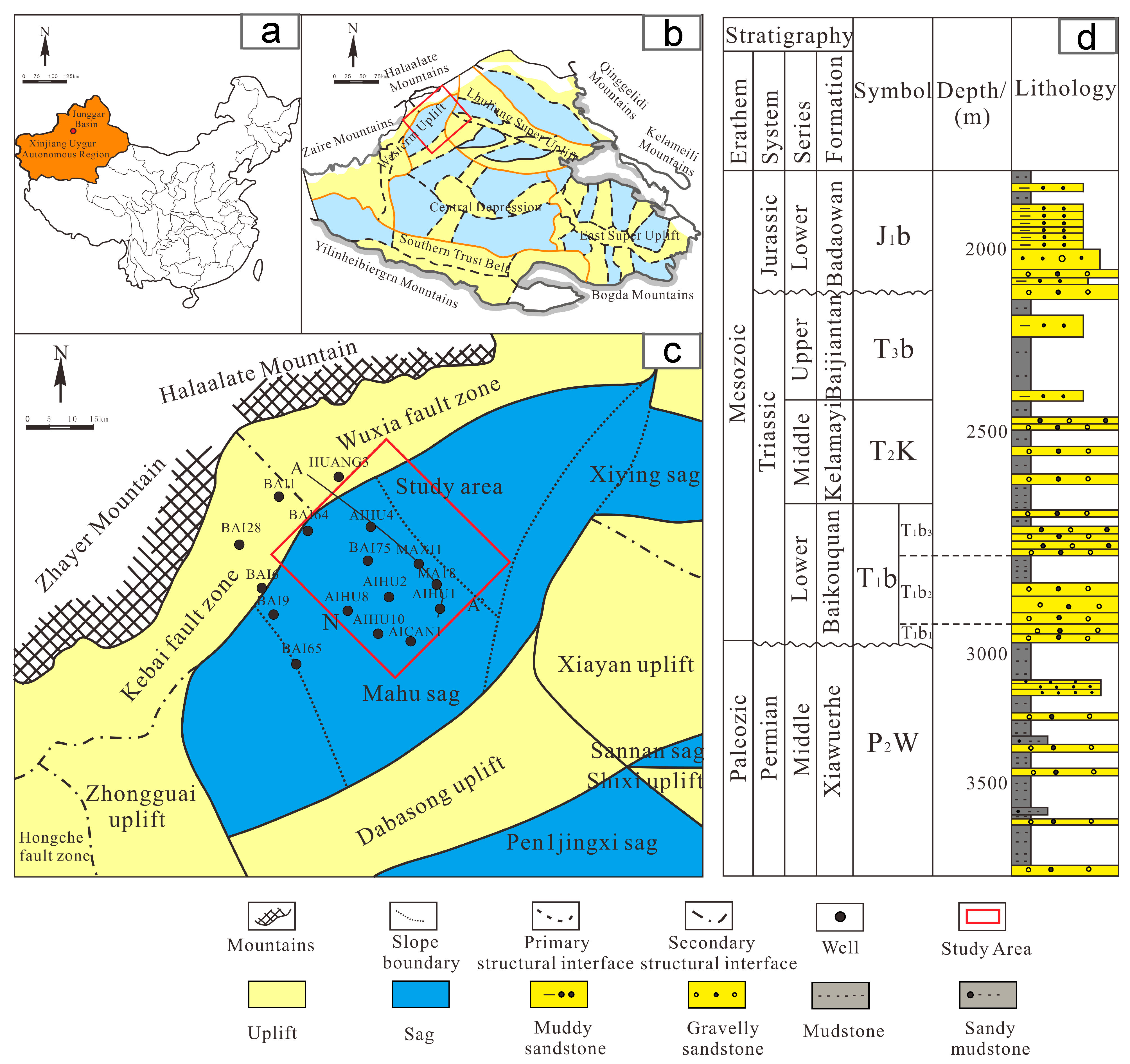
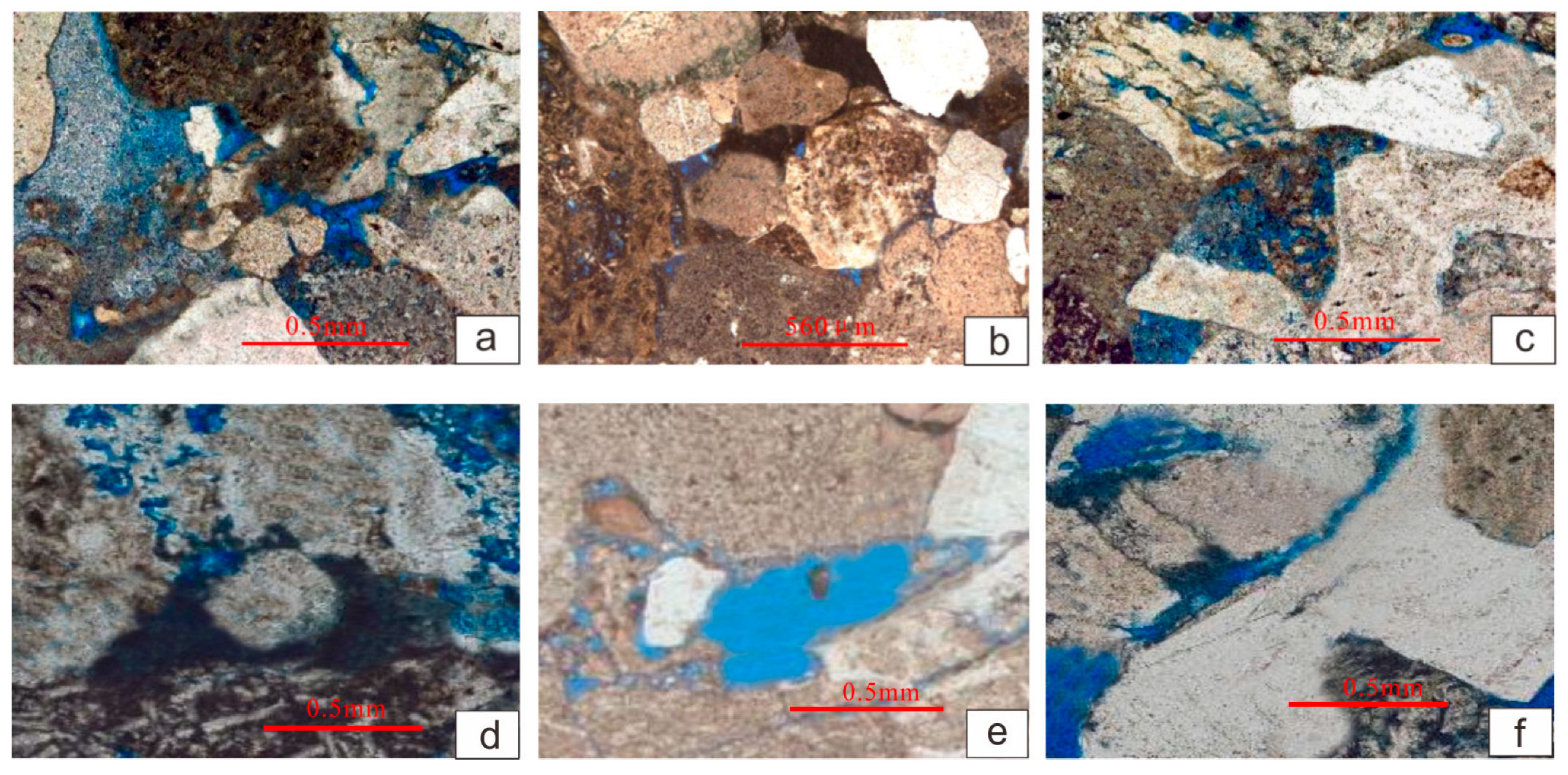
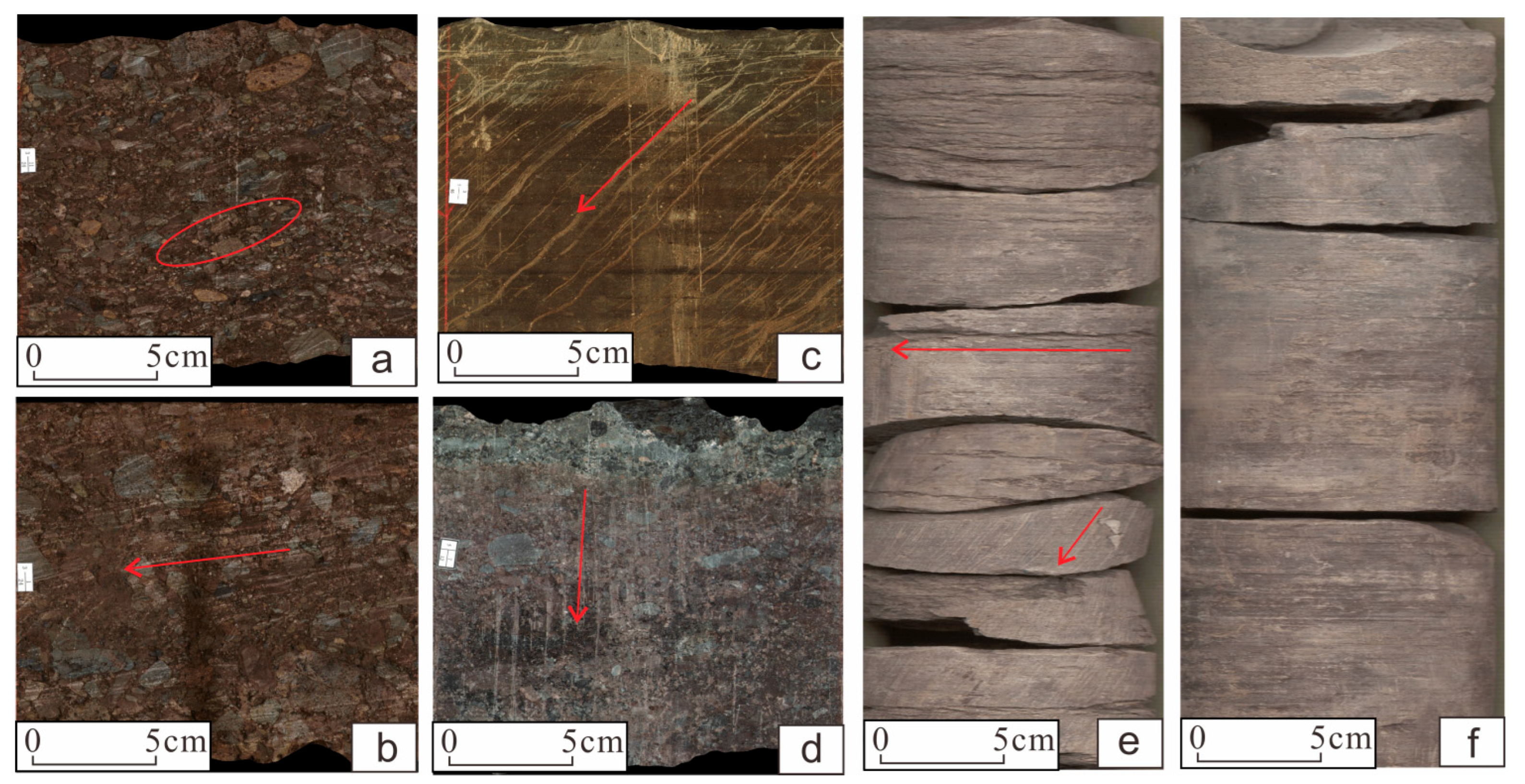
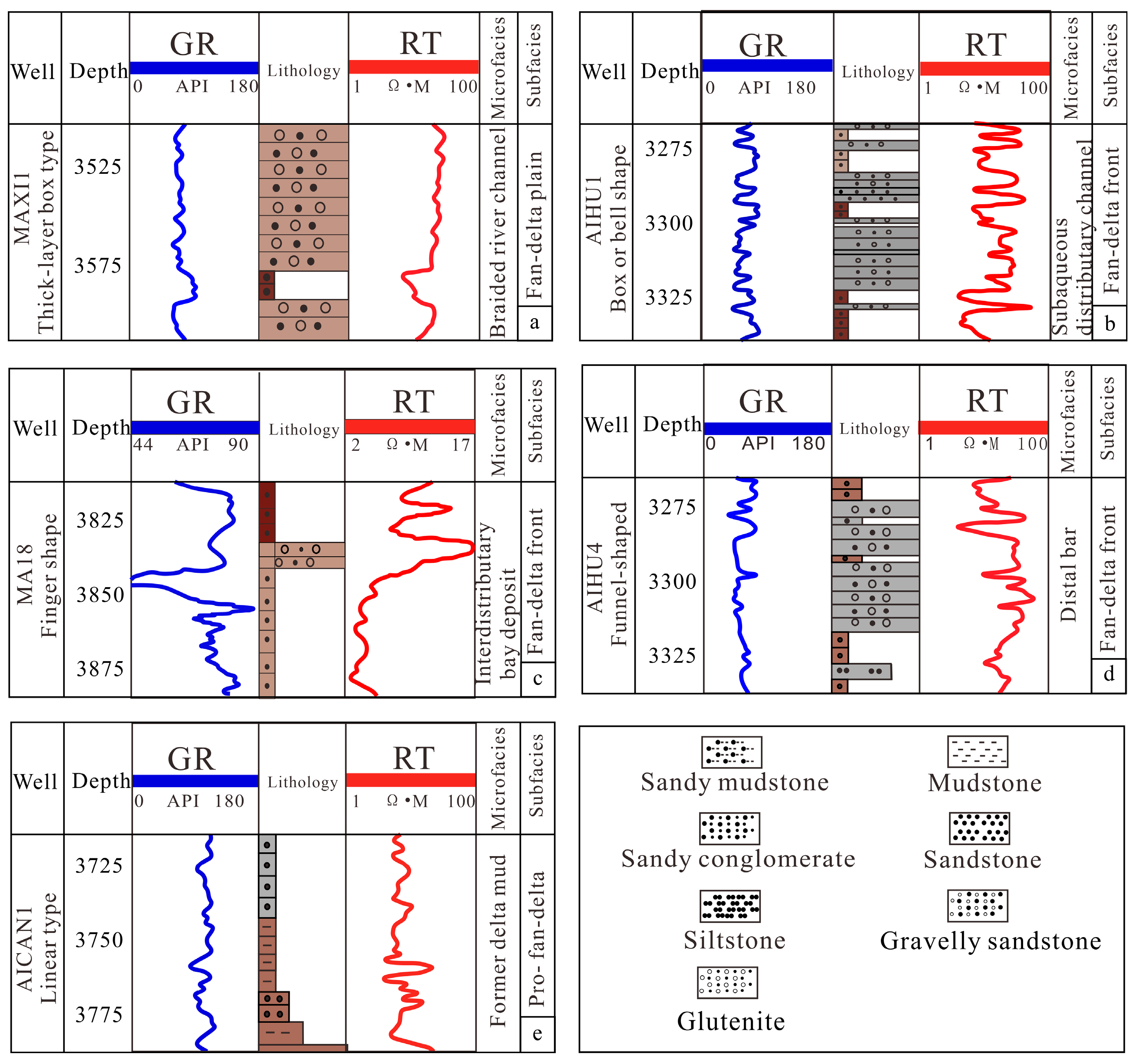
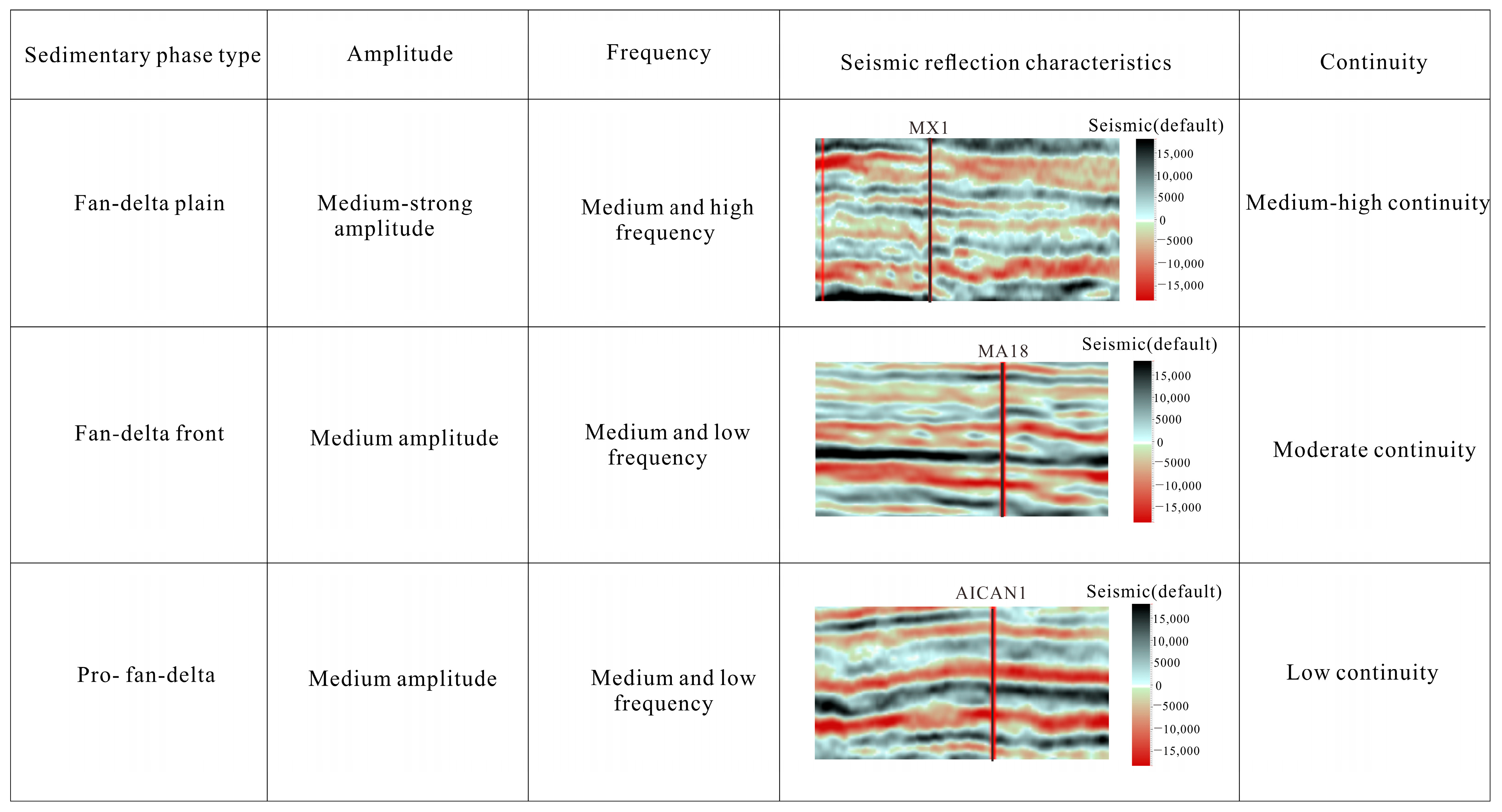
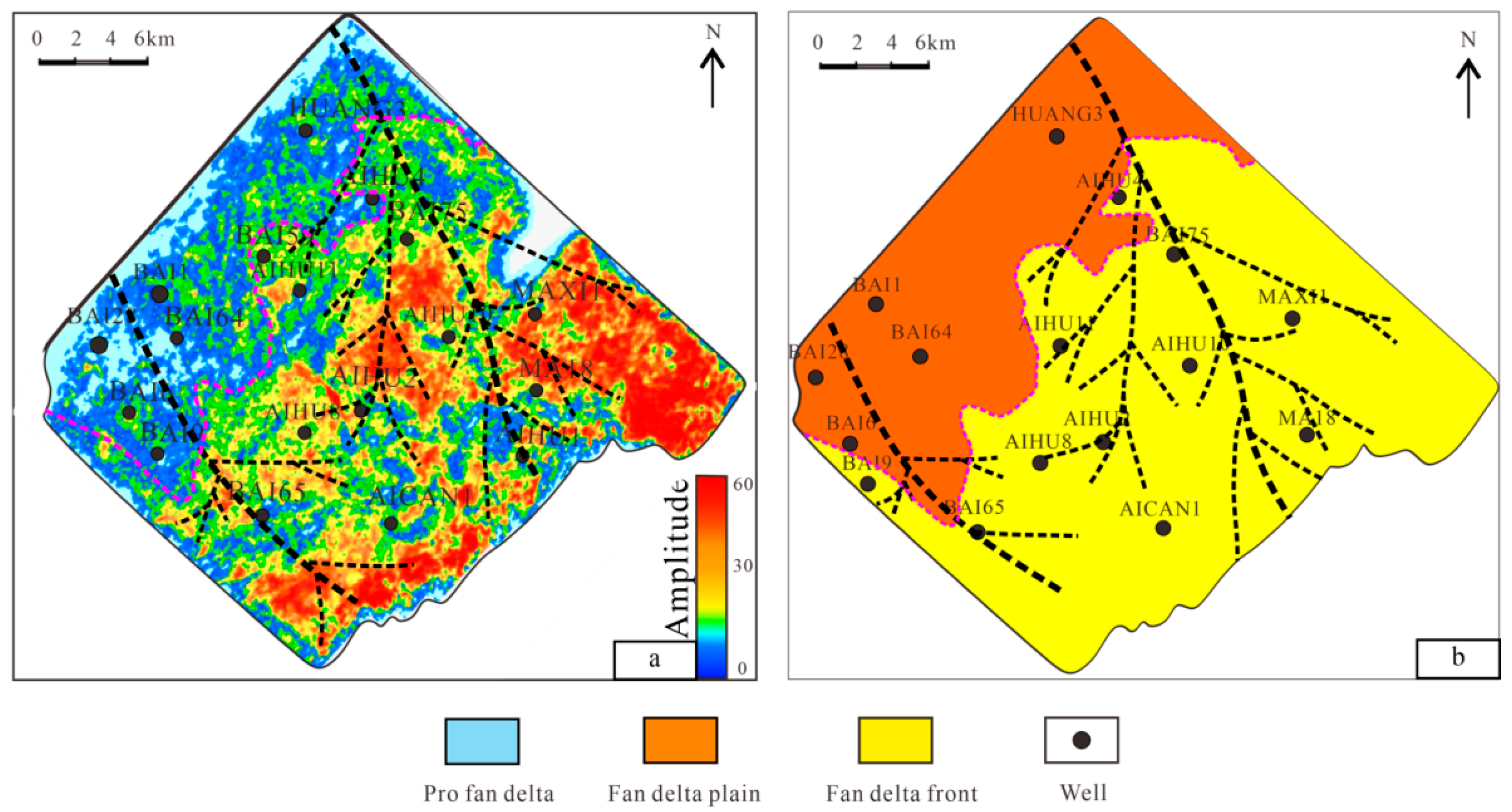
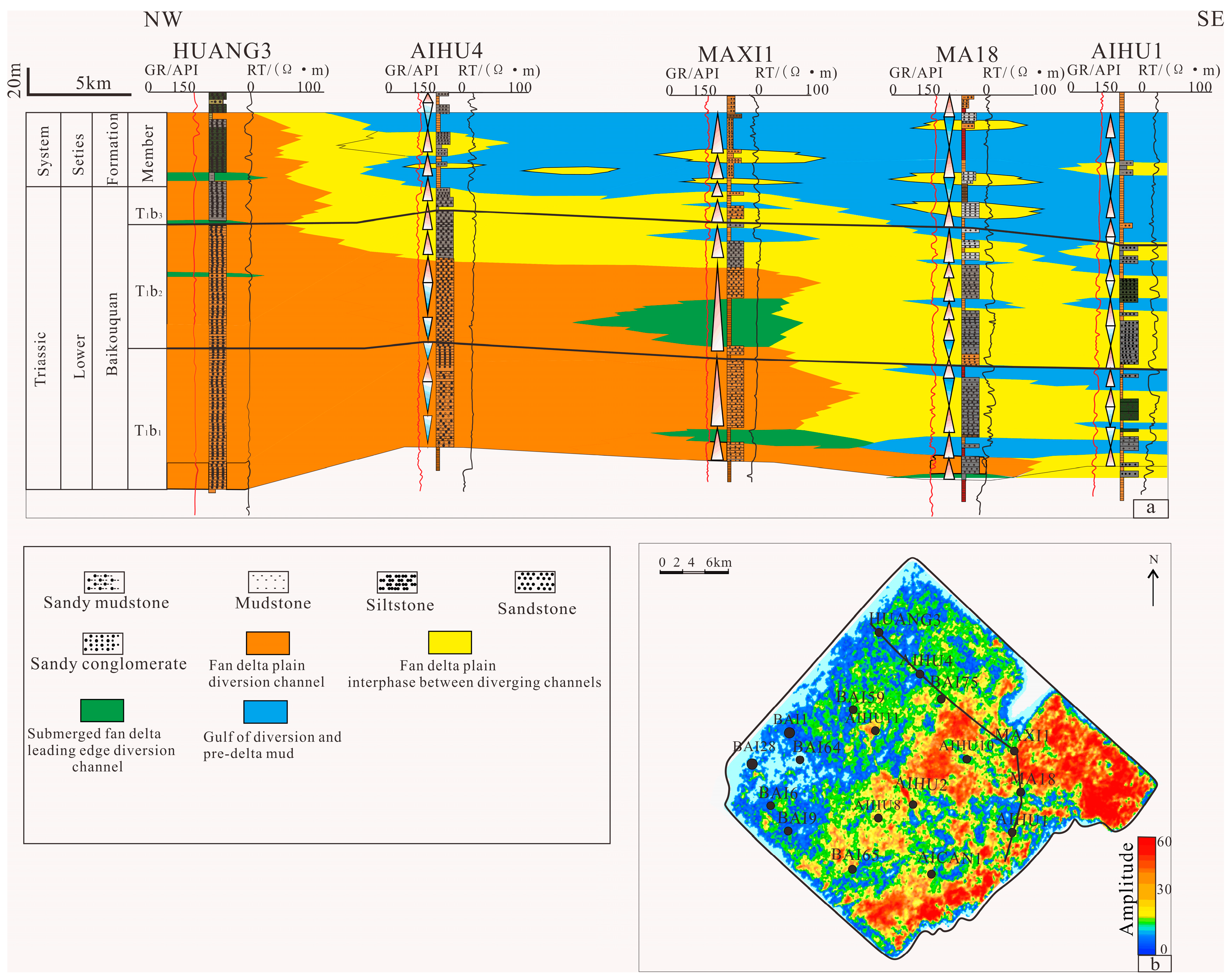
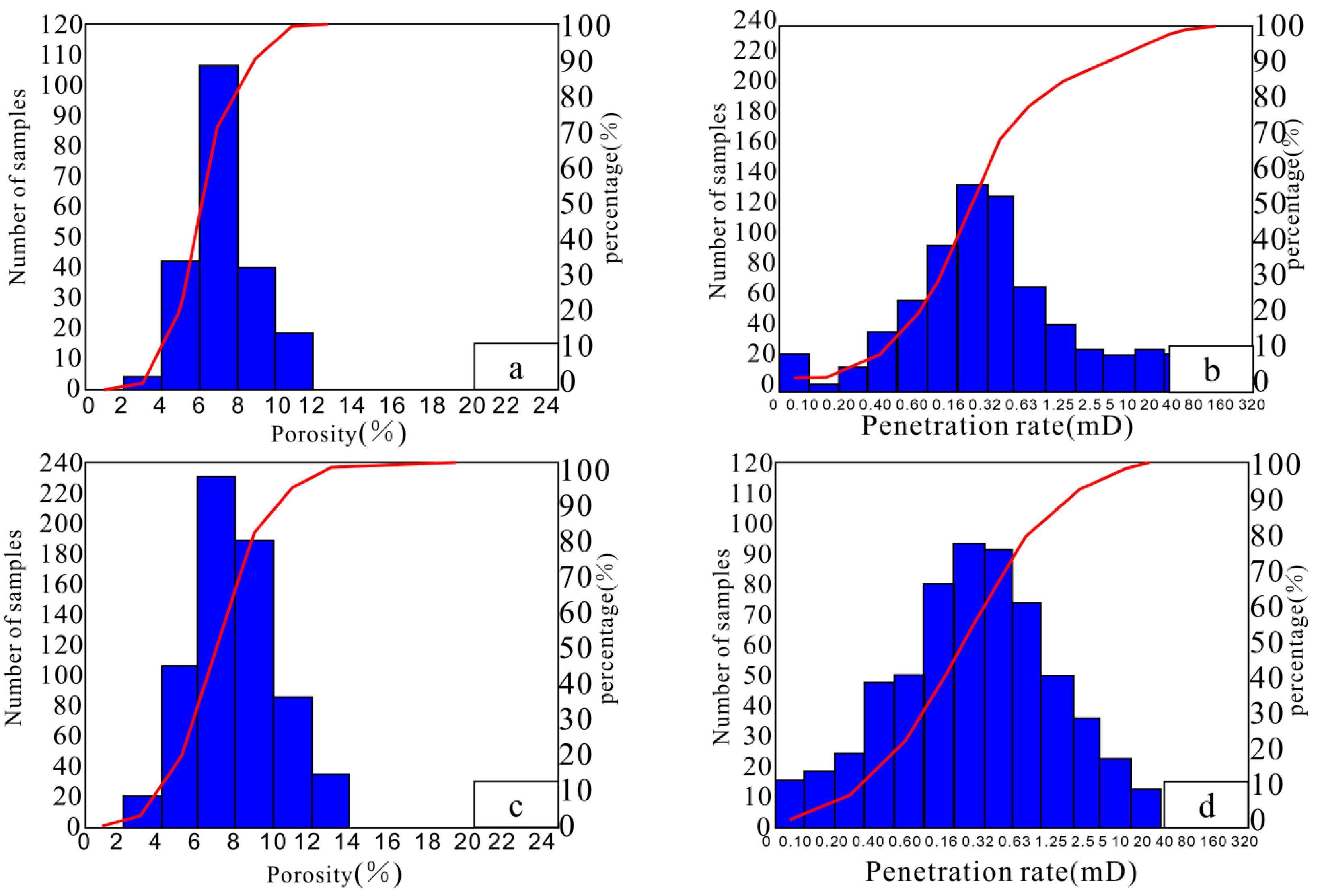
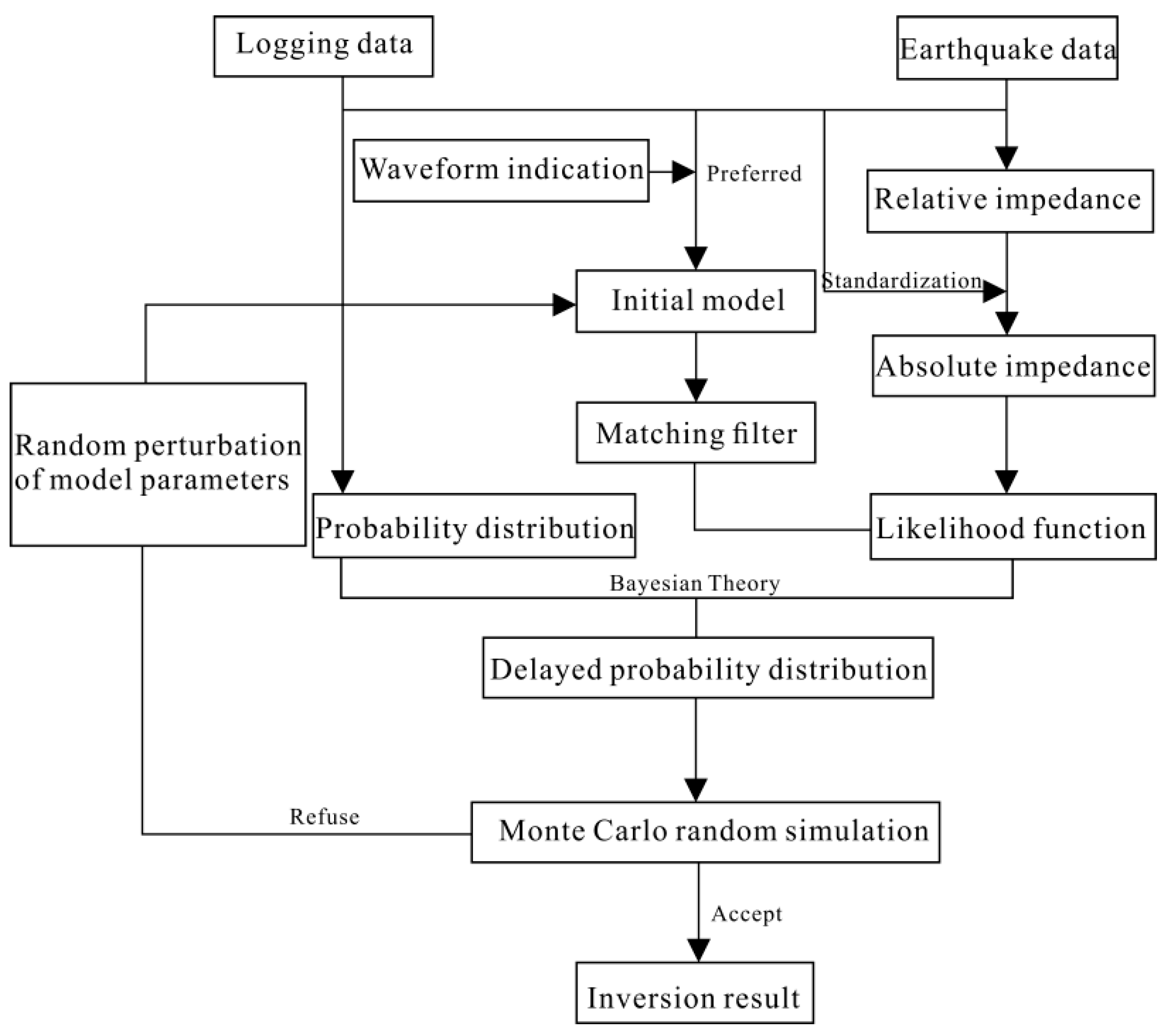
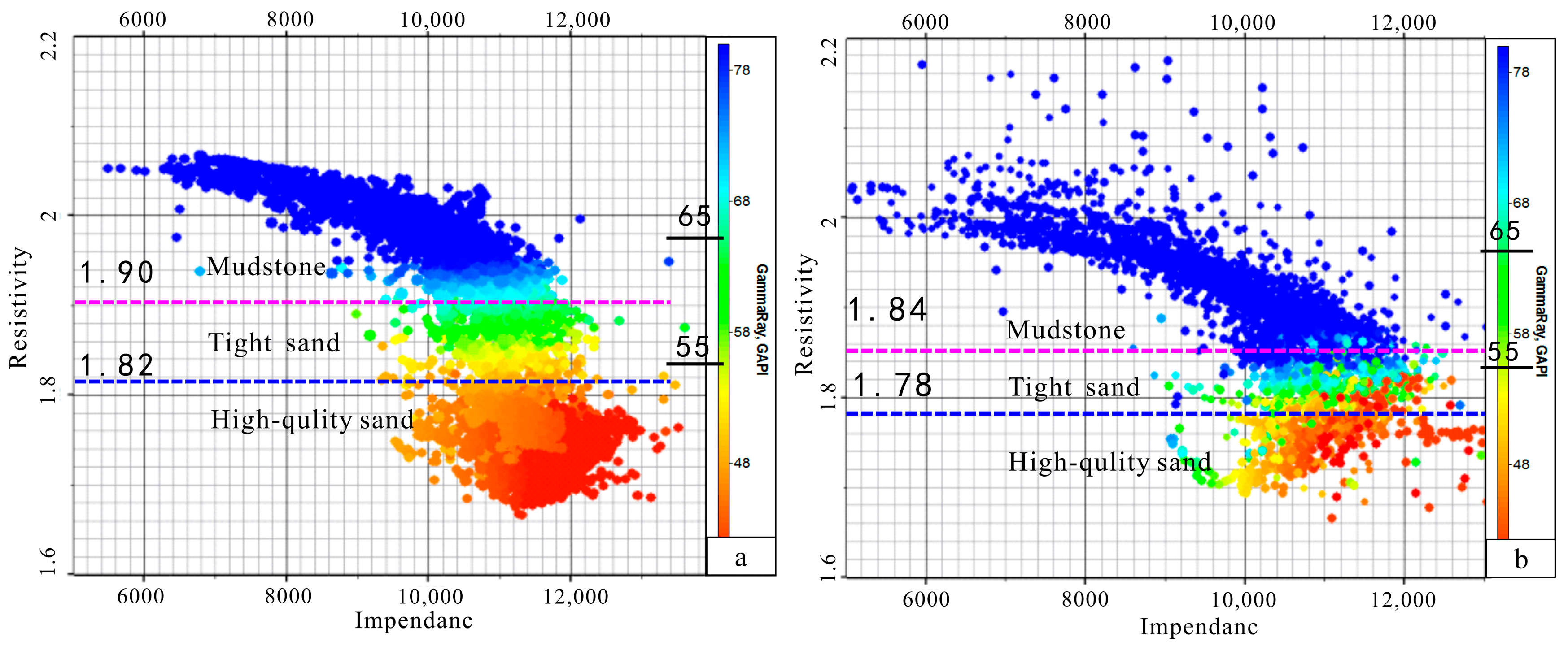
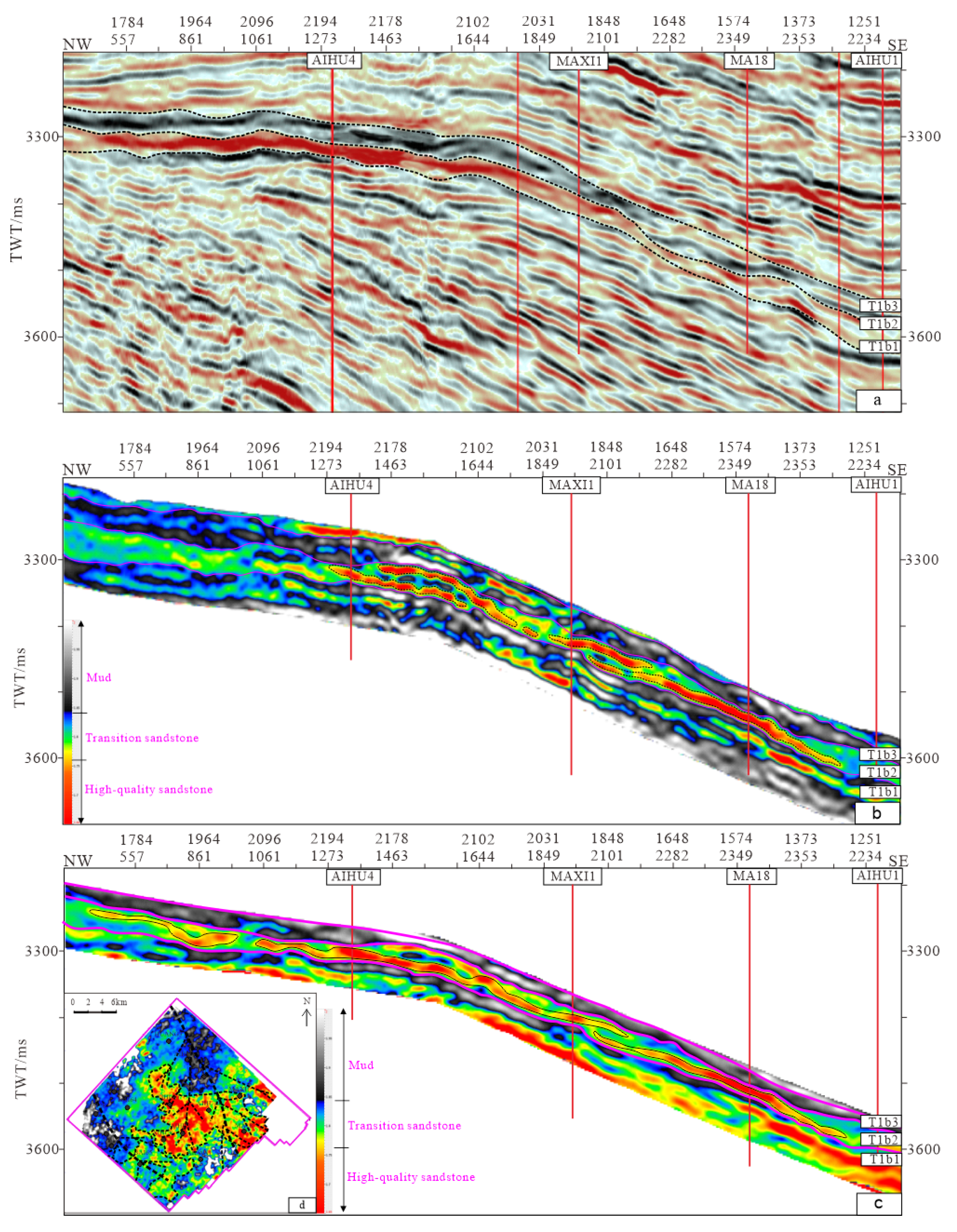
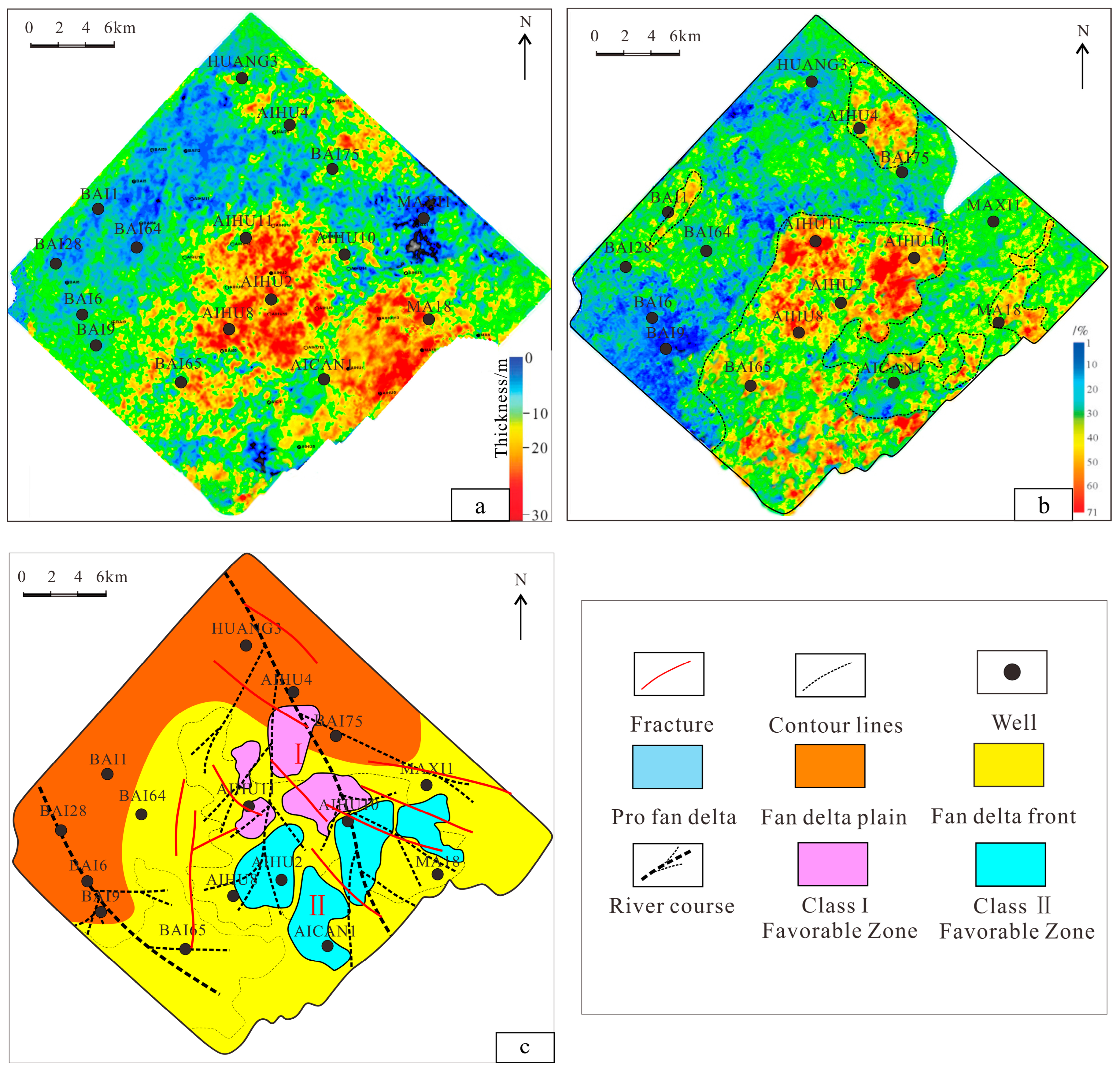
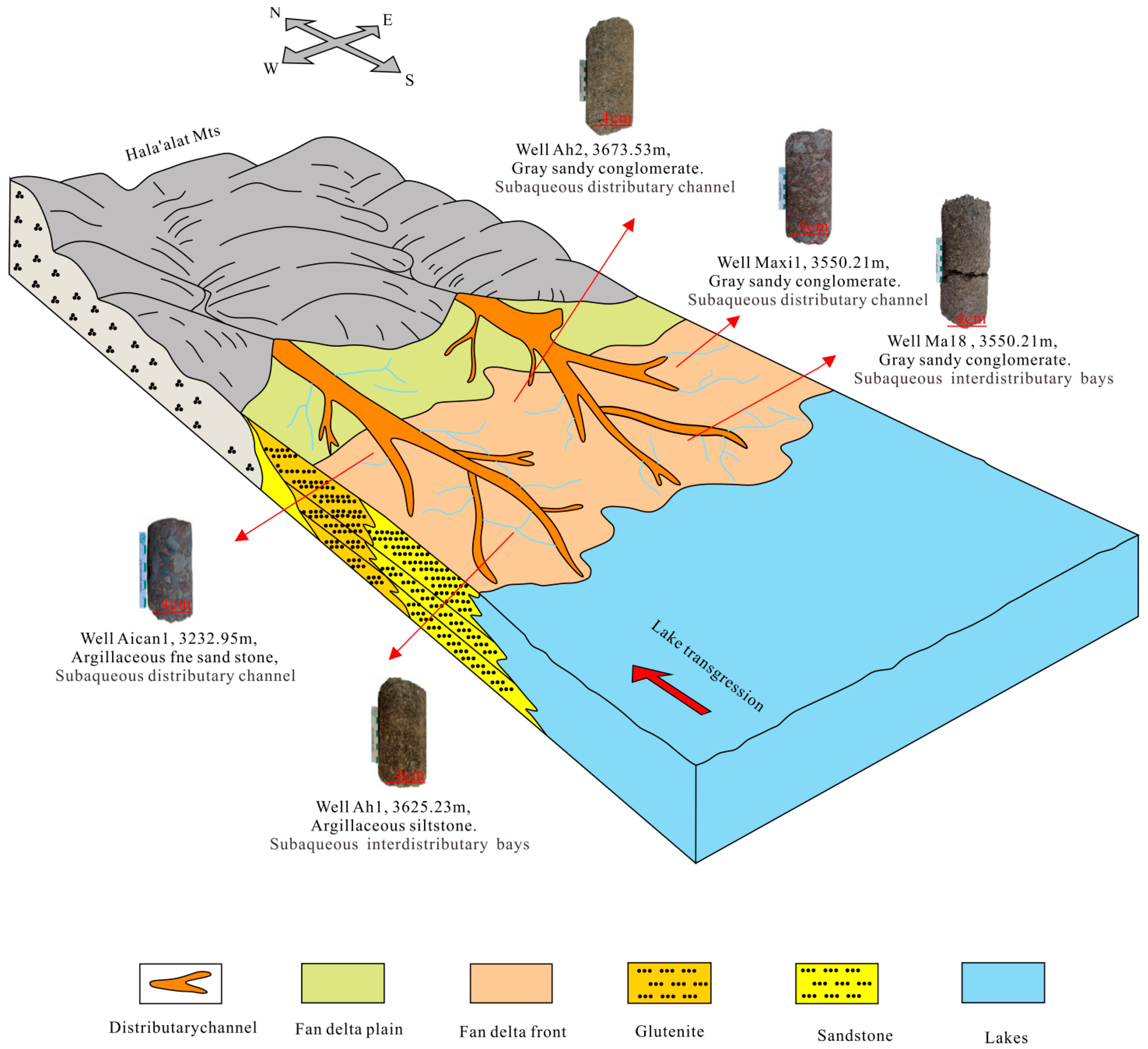
| Statistical Well | Horizon | Conforming Wells | Conformity Rate |
|---|---|---|---|
| MAXI | T1b2 | conformity | 0.83 |
| AICAN1 | conformity | ||
| MA18 | conformity | ||
| AIHU1 | conformity | ||
| AIHU2 | conformity | ||
| AIHU10 | conformity | ||
| BAI9 | inconformity | ||
| BAI75 | conformity | ||
| BAI65 | conformity | ||
| BAI64 | inconformity | ||
| HUANG3 | conformity | ||
| MAHU1 | conformity |
| Well | Predicted Thickness/m | Actual Thickness/m |
|---|---|---|
| MAXI1 | 6.21 | 6.53 |
| AIHU1 | 6.23 | 6.34 |
| AIHU4 | 6.23 | 6.38 |
| MA18 | 6.22 | 6.31 |
| AIHU2 | 6.35 | 6.46 |
| AIHU10 | 6.47 | 6.56 |
| BAI9 | 6.43 | 6.55 |
| BAI75 | 6.53 | 6.61 |
| BAI65 | 6.76 | 6.81 |
| BAI64 | 6.55 | 6.69 |
| HUANG3 | 6.32 | 6.58 |
| MAHU1 | 6.14 | 6.32 |
| Favorable Sand Body Type | Sand Body Thickness/m | Sand Ratio | Porosity/% | Permeability/×10−3 Mu m2 |
|---|---|---|---|---|
| Class I | >40 | >0.6 | >14 | >12 |
| Class II | >30 | >0.4 | ||
| Class III | >15 | >0.2 |
| Horizontal Well Name | Average Value of Actual Wave Impedance | Lithology of Actual Drilling | Predict the Average Value of Wave Impedance | Predict the Reservoir | Matching Condition |
|---|---|---|---|---|---|
| MAXI1 | 10,800 | High-quality sandstone | 11,300 | High-quality sandstone | Match |
| AIHU1 | 11,000 | High-quality sandstone | 11,250 | High-quality sandstone | Match |
| AICAN1 | 10,800 | High-quality sandstone | 11,000 | High-quality sandstone | Match |
| MA18 | 10,700 | High-quality sandstone | 11,300 | High-quality sandstone | Match |
| MAHU1 | 9200 | Mudstone | 9500 | Mudstone | Match |
| MAHU101 | 9000 | Mudstone | 9500 | Mudstone | Match |
| HUANG3 | 10,500 | High-quality sandstone | 10,750 | High-quality sandstone | Match |
| KE81 | 10,400 | High-quality sandstone | 11,500 | High-quality sandstone | Match |
| AIHU2 | 11,500 | High-quality sandstone | 11,200 | High-quality sandstone | Match |
| XIA85 | 11,400 | High-quality sandstone | 11,950 | High-quality sandstone | Match |
Disclaimer/Publisher’s Note: The statements, opinions and data contained in all publications are solely those of the individual author(s) and contributor(s) and not of MDPI and/or the editor(s). MDPI and/or the editor(s) disclaim responsibility for any injury to people or property resulting from any ideas, methods, instructions or products referred to in the content. |
© 2025 by the authors. Licensee MDPI, Basel, Switzerland. This article is an open access article distributed under the terms and conditions of the Creative Commons Attribution (CC BY) license (https://creativecommons.org/licenses/by/4.0/).
Share and Cite
Wang, J.; Chen, X.; Liu, X.; Huang, Y.; Su, A. Prediction of Favorable Sand Bodies in Fan Delta Deposits of the Second Member in Baikouquan Formation, X Area of Mahu Sag, Junggar Basin. Appl. Sci. 2025, 15, 10908. https://doi.org/10.3390/app152010908
Wang J, Chen X, Liu X, Huang Y, Su A. Prediction of Favorable Sand Bodies in Fan Delta Deposits of the Second Member in Baikouquan Formation, X Area of Mahu Sag, Junggar Basin. Applied Sciences. 2025; 15(20):10908. https://doi.org/10.3390/app152010908
Chicago/Turabian StyleWang, Jingyuan, Xu Chen, Xiaohu Liu, Yuxuan Huang, and Ao Su. 2025. "Prediction of Favorable Sand Bodies in Fan Delta Deposits of the Second Member in Baikouquan Formation, X Area of Mahu Sag, Junggar Basin" Applied Sciences 15, no. 20: 10908. https://doi.org/10.3390/app152010908
APA StyleWang, J., Chen, X., Liu, X., Huang, Y., & Su, A. (2025). Prediction of Favorable Sand Bodies in Fan Delta Deposits of the Second Member in Baikouquan Formation, X Area of Mahu Sag, Junggar Basin. Applied Sciences, 15(20), 10908. https://doi.org/10.3390/app152010908






